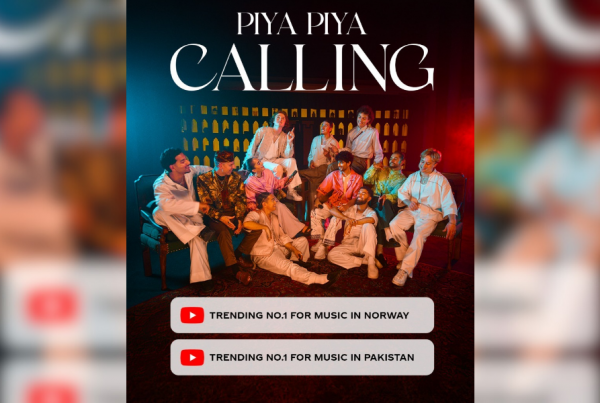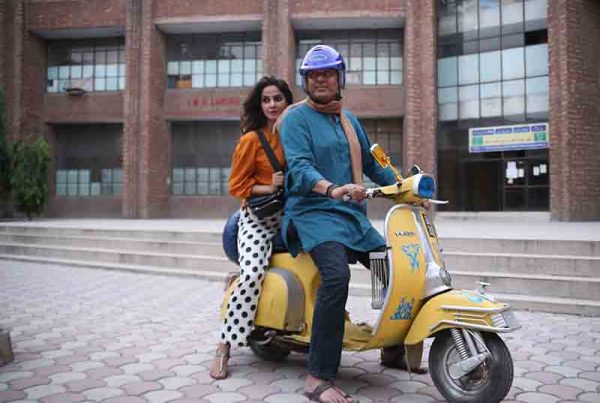Everyone is waiting for Chalay Thay Saath, a melodious song of a film that is rolling in as romantically as the rumbling clouds of the monsoon season. As fresh as the first drop of rain on parched soil, the film features a very new cast and crew. With first time director, Umer Adil and his wife Beenish on the Director and Producer’s seat, CST will be Syra Shehroz’s big screen debut with Canadian-Chinese actor Kent Leung, who has been promoting the film in Pakistan for the last two weeks. Add a debutant supporting cast – Osama Tahir, Faris Khalid, Zhaley Sarhadi and Mansha Pasha – to an equally upbeat and buoyant soundtrack (also featuring several indie musicians) and you have a film that projects brand Pakistan and appeals to a wide cross section of cine-goers, young and old. Chalay Thay Saath has a homogenously feel-good factor, which is perhaps integral to break the current dry spell cinema is going through.
It’s also a relief that CTS taps into relations with one of our friendly neighbors – China. You have Leung on the cast and the story moves along the Pakistan-China border; some parts of the film have even been shot in Hong Kong. But does it pedal a CPEC-agenda, as is perception? I was curious to know as I drove across to the director’s residence in Defense. This is where Syra and Kent were stationed for the day for interviews, and by the looks of the mini buffet that sat in front of them – all sorts of Pakistani tea treats – it did appear like they were making a picnic of it.
So, was Chalay Thay Saath a Pak-Cheen dosti project, I asked, wanting to get that frequently asked question out of the way.
“I wrote the story ten years ago,†Umer Adil, the director, clarified. “I was doing a project back then and there was no existence of CPEC. Recently when I started work on it, two three years ago, it just happened that the CPEC thing started to develop.â€
“It was a lucky coincidence,†Beenish, Adil’s wife and co-producer of the film added. “We would have still done the story if CPEC hadn’t happened.â€
They made it very clear that this wasn’t a government funded film and if anything, initially the film piqued the authorities’ curiosity.
“They did contact us,†he said. “But it was more like, what are you shooting? Why are you going to Khunjerab? Why are you shooting? Why is the Chinese actor coming in?†Clearly, there was no government help or sponsorship involved.
How did the Chinese actor come in, I was curious to know? By now everyone has seen and read about Kent S Leung, the Canadian-Chinese actor who has been on a relentless promotional tour in Pakistan for the last two weeks. His charm, wit and amiable disposition has won him many fans, even before the movie’s release. So how did the script approach him?

The cast of Chalay Thay Saath: (L – R) Faris Khalid, Usama Tahir, Syra Shehroz, Mansha Pasha, Zhalay Sarhadi, Kent Leung.
“I was in Vancouver, last winter, and my agent in China emailed me saying ‘I have this Pakistani project, they’re looking for an actor and I think you’d be really good for it,’†he shared. “I was so caught off guard. At first I thought she would bring me Chinese work and she brought me this Pakistani project. Not to be culturally insensitive but I was like, what, Pakistan makes films? I did think that for a second. I got more information about the film, googled most of the film members and was like okay, this is legit and after talking to them I realized that this is going to be a commercial film. It’s going to be mainstream. Key thing was that it’s not going to be an indie film. I’ve done indie films before and every actor wants to keep moving up in their career.â€
What inspired Syra to come onboard? The young actress has been around for several plays but she had evaded a big screen project so far. What was the deciding factor on CTS?
“I had read other scripts but nothing was clicking,†she said, while sinking into an oversized cushion on the couch she was nestled in. Dressed in white and yellow, Syra did remind me of an endearing birdling preparing for first flight. “I wanted my debut to be different from what was happening because nothing at that time was really working. Maybe one out of ten films that we were making were working. So first Beenish narrated the story for me and after 14-15 drafts, we felt the final one worked. I was like, okay, I want to do this for sure.â€
With the cast and crew on board, filming was a quick 40-day process. Used to an urban lifestyle, Syra shares how she felt she was constantly surrounded by wild animals; the first morning she woke up to the incessant chirping of birds and she thought there were wild animals outside her window. An ominous hissing under her bed had her convinced there was a snake in her room; it led to many sleepless nights.
“She thought there was a Jungle Book outside!†Kent laughed, adding more insight to the humour of the situation.
They had fun, evident in the final look and feel of the film. But was there more to Chalay Thay Saath than visual relief and romance? We had been hearing about the film and the strong connection between Pakistan and China that it was hinged upon, the friendship ties, the economic ties etc. Pakistan is big on social issues and agenda driven subjects these days. Did Kent feel movies should be politically motivated or should they just be pure entertainment, I asked him.
“I think every film should have a message,†he replied. “Whether it is political or social, whatever it is, whoever writes it and directs it should care about something. If that affects people, then it affects people. That’s really up to the artist.â€
So what is the message in Chalay Thay Saath?
“The message in the film is Pak-Cheen dosti zindabad,†Syra laughed. “The movie sort of deals with all kinds of relationships in your life, be it your friends or your family. The message this movie gives is that, how should I put it…â€
“I think one of the key themes is that you don’t know what’s going to happen,†Kent chipped in. “Each of the characters in the duration of the film encounters something that they had no idea was going to happen to them. They encounter an issue they didn’t predict. Life just happens.â€
“Whether there is love or loss, nothing can be planned and it’s really how you deal with those aspects of life,†Syra added. “It deals with that stuff. I think the message is just that stay strong.â€
Coming back to how beautiful the film looks, Kent reassured that it was larger than life and didn’t look like a TV production at all. Which brought me to my next question: one had noticed a glaring lack of intimacy in new-age Pakistani films. Lead pairs had no passion and even beyond the romance of the hero and heroine, there was a lack of emotion, of climax, of fireworks. It appeared as if films began and ended on a flat line, which was the polar opposite of the overemotional Punjabi and Pushto movies the nation fed on in the eighties. Not to go back there, would CTS at least shake things around; could one expect an intimacy of human relations?

“What’s the definition of intimacy here?†Kent asked innocently, somewhat serious and somewhat tongue in cheek.
“I don’t want to give it away,†Syra responded. “Because you’ll see what the graph will be like so you won’t have a problem with us not exactly touching too much. Then there’s Mansha and Usama and they’re a married couple. I think they’re being quite ‘married’ in the movie.â€
Don’t you feel that there’s a lack of passion when it comes to relationships between men and women in films, I asked her? I mean, Punjabi and Pushto films operate in hormone overdrive so it obviously isn’t a censorship issue.
“How far can we go?†Syra thought aloud. “For me, I still can’t accept Bollywood stars kissing on screen. I grew up when they wouldn’t kiss on screen. But if I’m watching a Hollywood film, then it all seems okay. I think it’s the mindset, maybe we’ll ease into it.â€
“I think everyone is scared at this point,†she answered her own question. While there is passion on the small screen, films are treading very carefully. They are proceeding with caution.
So were people going to accept a Pakistani girl falling in love with a Chinese boy?
“There’s a twist in the film,†Syra offered. “But I personally know so many girls who’ve married foreigners. I think its relatable.â€
“Actually, there are a lot of inter racial marriages near the Pakistan and China border,†Umer chipped in. “A lot of people in Hunza have their families in China. We got a lot of messages from people who said ‘Oh, I’m marrying a Chinese guy/girl and this is so relatable for me’.â€
“When I saw the border, I saw that the people are so connected,†he added, explaining the idea behind the film. “We have tried to portray Pakistan in a slightly different way. There are other realities in Pakistan as well so we decided to show them.â€
“The film’s setting plays a very important part in the film,†Beenish wrapped it up. “It’s not just a majestic back drop.â€
This backdrop will be the premise of this interracial love story and it seems like it’s not just a love story of two people or two couples. Chalay Thay Saath seems like a love story with Pakistan, it’s people and myths and stories. And it looks pretty good.
This article was first published in Instep, 16th April.Â





